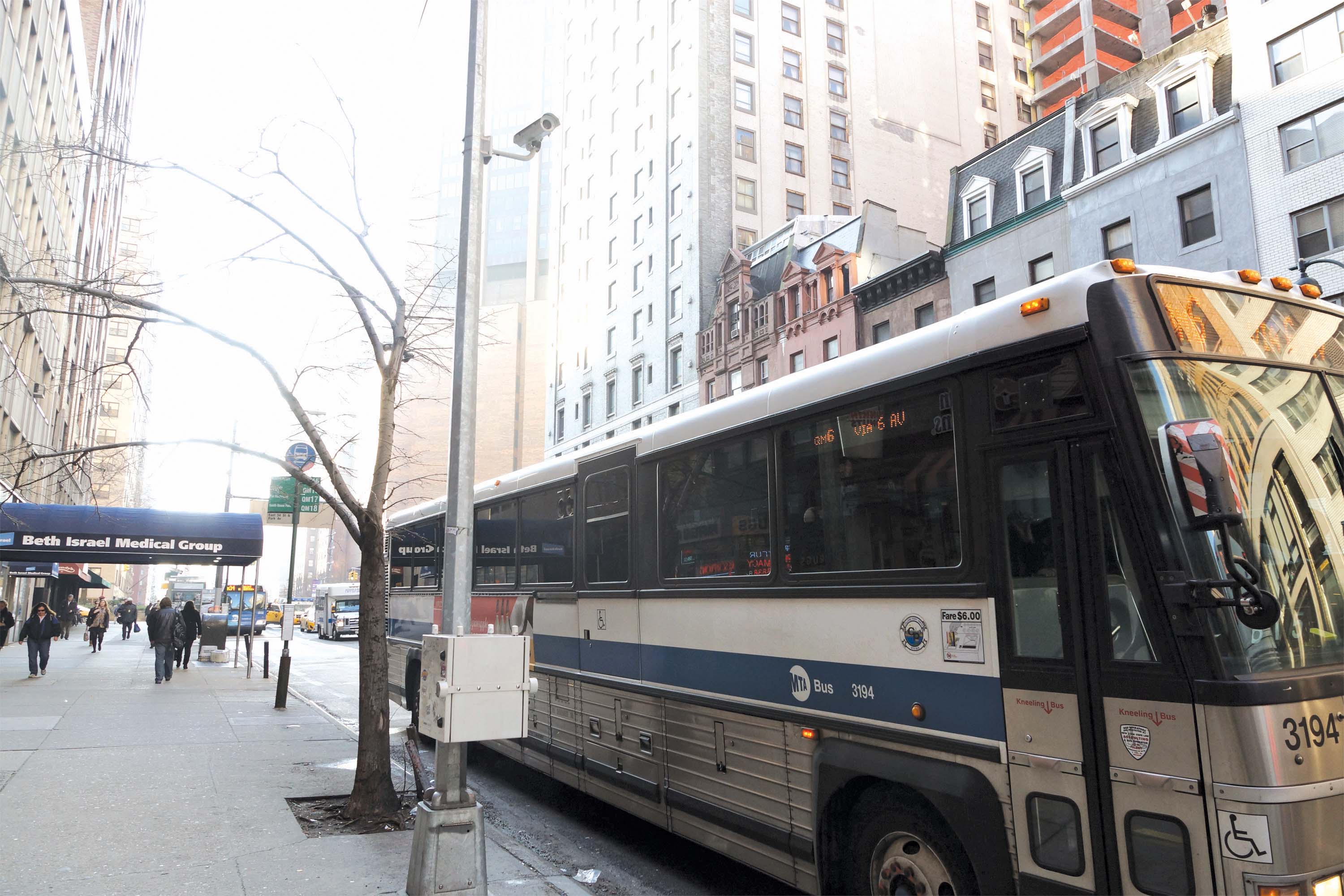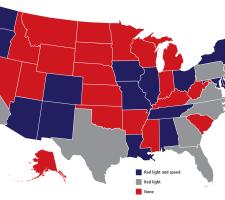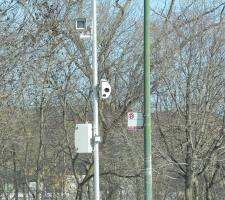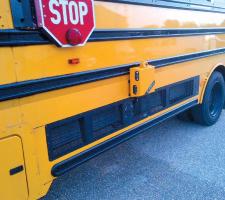
Applications such as bus lane enforcement highlight the increasing emphasis on multimodality in the US’s major cities
The US automated enforcement market is in rude health as the number of systems and applications continues to grow and broaden. Jason Barnes reports.
Blessed and cursed – arguably, in equal measure – with a constitution which stresses the right to self-expression and determination, the US has had a harder journey than most to the more widespread use of automated traffic enforcement systems. In some cases, opposition to the concept has been extreme – including the murder of a roadside civil enforcement official, as happened in 2009 – and wrangling over issues such as privacy has been refined to a fine art.
Nevertheless, the vociferousness and vitriol of single-issue groups and individuals notwithstanding, the country is making progress with automated enforcement. More to the point, the range of applications is increasing. In addition to red light and speed, school zone and school bus stop arm enforcement solutions have made notable progress – the last-mentioned has in fact been the fastest-growing enforcement application in the US over the last two years (see page NA8). Cities such as Chicago and New York have made concerted efforts to target unsafe driving which endangers pedestrians, particularly but not exclusively around schools (see ‘Speed enforcement bears fruit in the Big Apple’). The nation’s capital, meanwhile, has recently launched the D.C. StreetSafe programme which is using cameras to enforce a whole range of offences (see sidebar, ‘Capital offences’).
834 National Highway Traffic Safety Administration (NHTSA), in 2012 nearly 11,000 Americans lost their lives because of such incidents. Although the police unions have in some places criticised the use of automated systems as an alternative to live personnel, the fact remains that such systems are cost-efficient and proving to be effective in use. In quite a number of cases, the improvements in driving they bring about can only be described as major. 17 American Traffic Solutions (ATS), a major supplier to the US enforcement market, cites a reduction in school bus stop arm violations of 43.8% in Cobb County, Georgia, for example.
The company has 400 cameras installed on buses in six states, and says that the incidence of reoffending by those who have received a citation is less than 1%. In Newark, New Jersey,112 Redflex cites a 64% reduction in accidents of all types, with T-bar collisions down by 69% and rear-end collisions by 61%. Very recently, Bakersfield, California, released data which showed that from November 2004 through to September 2013 primary accidents decreased to an average of 4.5 per year, representing a 73% decrease overall.
In 1987 ATS installed the first automated camera in the US (in Arizona) and the latest figures show that by the beginning of 2014 there were almost 7,000 enforcement cameras of some description in operation across the country. At the beginning of February 2014, there were 650 speed and red light safety camera programmes in operation; 499 communities had red light camera programmes and 134 communities have speed camera programmes (this includes state-wide work zone safety programmes in Illinois, Maryland and Washington). Nationally, around half of all US states and the District of Columbia now use automated enforcement in some form or another.
79 Jenoptik. Redflex is part of a multinational concern with offices in Europe, Australasia and North America which offers comparable solutions from a common international product portfolio of its own creation.
Both companies are actively marketing solutions with non-invasive camera triggering technologies, in line with the broader traffic management trend away from in-ground sensors which require lane closures and civils works for installation and maintenance. Both have also developed solutions to address specific needs within the North American market. An example is the school bus stop arm sector, for which ATS offers the CrossingGuard system and Redflex the similar Student Guardian (see also pageNA8). These offer vehicle-mounted camera solutions designed to address a problem estimated by the National Association of State Directors of Pupil Transportation Services to amount to 15 million illegal passes nationally in a typical 180-day school year.
As interest in automated enforcement ramps up, the two companies are marketing portfolios which reflect the growing number of applications to be found in the US. Some are of greater importance nationally than in some other countries – railroad crossing enforcement is an example. Others reflect changes in US transportation policy to embrace multi-modalism and a maturing of the US market which is reflected in the adoption of solutions already deployed commonly in other countries, such as pedestrian intersection protection, bus lane enforcement and automated systems to keep intersections clear and in order to prevent gridlock. Levels of sophistication are also rising, with the launch of systems which will intervene in traffic signal phasing and extend green phases where a T-bar incident appears inevitable, for instance.
Although private-sector involvement in operations has resulted in criticisms – and opposition based in part on suspicions of profiteering – business models are evolving with greater emphasis being placed on results-led rather than per-violation incentives. Press releases relating to school bus stop arm enforcement in Cobb County, for example, highlight the falling number of recorded offences as evidence of the success of the scheme in operation there.
A long-standing issue in the US – as elsewhere – is that while individual members of the public, when surveyed, see automated enforcement as a good idea, those same individuals also perceive broad public opinion to be negative.
The major suppliers have therefore also worked actively to constructively mould public and media opinion and there is also effort from the public-sector side to address matters. Some states are working to effect vehicular registration holds for scofflaw offenders, thereby assuring that violators are held accountable for their offences. This is not simply an economic pursuit, as behaviour modification creates improved driving behaviour and safer roadways. Other states, such as Texas, Florida and Pennsylvania, legislate that a certain proportion of ticket revenue generated through photo enforcement programmes supports brain trauma funds. This is another innovative concept supporting the greater good for the community.
The overall effort has included working with local jurisdictions and other stakeholders to counter legal challenges to the use of automated enforcement. By comparison with past years, there are signs that these efforts are succeeding. In California, for example, Redflex has been working with local partners to reduce photo enforcement fines and impose civil rather than criminal liabilities. In Ohio, where the legislature considered a ban on photo enforcement, the law enforcement community united to give strong opposition to the bill. Broad data from a coalition of state-wide partners was presented which detailed why considered reform rather than an outright ban might be more prudent. At present, this is under consideration.
Capital offences
<%$Linker:2 External <?xml version="1.0" encoding="utf-16"?><dictionary /> 0 0 0 oLinkExternal On its website http://mpdc.dc.gov/page/dc-streetsafe-automated-traffic-enforcement false http://mpdc.dc.gov/page/dc-streetsafe-automated-traffic-enforcement false false %> the Metropolitan Police Department of the District of Columbia states that, with budgets always tight, automated traffic enforcement offers an excellent solution for making DC’s streets safer for all users. The US capital has had automated red light enforcement in operation since 1999 but the D.C. StreetSafe programme targets a whole range of offences which also includes speeding, gridlock (blocking intersections), ‘Stop’ sign violations, pedestrian right of way, intersection speed and oversized vehicle protection. Comprehensive online links explain each individual type of violation and also, where applicable, list the locations of cameras in order to give fair warning. Those receiving a citation can review it online using a unique PIN which is printed on the issued documents.
Speed enforcement bears fruit in the Big Apple
New York City’s Department of Transportation (5900 NYC DoT) intends to use 20 cameras citywide to target those who speed and endanger pedestrians. According to the New York Post, the scheme caught 900 offenders in the first two weeks of a six-camera pilot. At $50 per offence, that amounts to $45,000 in fine revenues.
Tickets are issued in the name of the registered owner where vehicles are recorded to be exceeding the posted speed limit by 10mph or more. No licence or insurance penalties are accrued.
NYC DoT Commissioner Polly Trottenberg has said that drivers are “on notice” that dangerous driving will not be tolerated.
The DOT refused to say where the six cameras in the pilot were located, saying only that some were stationary, others were moved periodically, and all were within a quarter-mile of a school with a scofflaw problem. At least three of the schools earmarked for the programme had a problem with drivers who sped 100% of the time.
Police unions have been critical of a scheme which they say replaces live professionally trained officers who, having stopped a vehicle for speeding, may also discover follow-on offences.
Blessed and cursed – arguably, in equal measure – with a constitution which stresses the right to self-expression and determination, the US has had a harder journey than most to the more widespread use of automated traffic enforcement systems. In some cases, opposition to the concept has been extreme – including the murder of a roadside civil enforcement official, as happened in 2009 – and wrangling over issues such as privacy has been refined to a fine art.
Nevertheless, the vociferousness and vitriol of single-issue groups and individuals notwithstanding, the country is making progress with automated enforcement. More to the point, the range of applications is increasing. In addition to red light and speed, school zone and school bus stop arm enforcement solutions have made notable progress – the last-mentioned has in fact been the fastest-growing enforcement application in the US over the last two years (see page NA8). Cities such as Chicago and New York have made concerted efforts to target unsafe driving which endangers pedestrians, particularly but not exclusively around schools (see ‘Speed enforcement bears fruit in the Big Apple’). The nation’s capital, meanwhile, has recently launched the D.C. StreetSafe programme which is using cameras to enforce a whole range of offences (see sidebar, ‘Capital offences’).
Push factors
Impetus comes from the continuing high numbers of deaths related to red light and speeding violations. According to theThe company has 400 cameras installed on buses in six states, and says that the incidence of reoffending by those who have received a citation is less than 1%. In Newark, New Jersey,
In 1987 ATS installed the first automated camera in the US (in Arizona) and the latest figures show that by the beginning of 2014 there were almost 7,000 enforcement cameras of some description in operation across the country. At the beginning of February 2014, there were 650 speed and red light safety camera programmes in operation; 499 communities had red light camera programmes and 134 communities have speed camera programmes (this includes state-wide work zone safety programmes in Illinois, Maryland and Washington). Nationally, around half of all US states and the District of Columbia now use automated enforcement in some form or another.
Technology
In terms of technology, the US is also managing to keep pace with – and in some cases outpace – other countries where there are established automated enforcement regimes. Digital camera technology was first introduced to the US at the turn of the century and some of the market’s major suppliers have moved to embrace digitisation’s potential. ATS has adopted state of the art digital technology developed by the Traffic Solutions division of German companyBoth companies are actively marketing solutions with non-invasive camera triggering technologies, in line with the broader traffic management trend away from in-ground sensors which require lane closures and civils works for installation and maintenance. Both have also developed solutions to address specific needs within the North American market. An example is the school bus stop arm sector, for which ATS offers the CrossingGuard system and Redflex the similar Student Guardian (see also pageNA8). These offer vehicle-mounted camera solutions designed to address a problem estimated by the National Association of State Directors of Pupil Transportation Services to amount to 15 million illegal passes nationally in a typical 180-day school year.
As interest in automated enforcement ramps up, the two companies are marketing portfolios which reflect the growing number of applications to be found in the US. Some are of greater importance nationally than in some other countries – railroad crossing enforcement is an example. Others reflect changes in US transportation policy to embrace multi-modalism and a maturing of the US market which is reflected in the adoption of solutions already deployed commonly in other countries, such as pedestrian intersection protection, bus lane enforcement and automated systems to keep intersections clear and in order to prevent gridlock. Levels of sophistication are also rising, with the launch of systems which will intervene in traffic signal phasing and extend green phases where a T-bar incident appears inevitable, for instance.
Evolving market
Among developed countries, the US has led the way in the in the use of public-private partnerships for enforcement. The major systems suppliers have from the earliest days offered managed services and not just systems, something which contrasts sharply with the situation in Western Europe, for example, where it remains common for enforcement to be a wholly public-sector concern.Although private-sector involvement in operations has resulted in criticisms – and opposition based in part on suspicions of profiteering – business models are evolving with greater emphasis being placed on results-led rather than per-violation incentives. Press releases relating to school bus stop arm enforcement in Cobb County, for example, highlight the falling number of recorded offences as evidence of the success of the scheme in operation there.
A long-standing issue in the US – as elsewhere – is that while individual members of the public, when surveyed, see automated enforcement as a good idea, those same individuals also perceive broad public opinion to be negative.
The major suppliers have therefore also worked actively to constructively mould public and media opinion and there is also effort from the public-sector side to address matters. Some states are working to effect vehicular registration holds for scofflaw offenders, thereby assuring that violators are held accountable for their offences. This is not simply an economic pursuit, as behaviour modification creates improved driving behaviour and safer roadways. Other states, such as Texas, Florida and Pennsylvania, legislate that a certain proportion of ticket revenue generated through photo enforcement programmes supports brain trauma funds. This is another innovative concept supporting the greater good for the community.
The overall effort has included working with local jurisdictions and other stakeholders to counter legal challenges to the use of automated enforcement. By comparison with past years, there are signs that these efforts are succeeding. In California, for example, Redflex has been working with local partners to reduce photo enforcement fines and impose civil rather than criminal liabilities. In Ohio, where the legislature considered a ban on photo enforcement, the law enforcement community united to give strong opposition to the bill. Broad data from a coalition of state-wide partners was presented which detailed why considered reform rather than an outright ban might be more prudent. At present, this is under consideration.
State of play
In broad terms, then, the US automated enforcement market is in a healthy and positive place. Public opinion is onside, despite the efforts of a tub-thumping minority. The technology continues to progress both in terms of sophistication and breadth of application. The number of deployed systems continues to grow as a product of the desire to improve safety and do so efficiently. And, as time goes on, the industry is becoming better and better at navigating its way through the obstacles which hitherto have challenged its growth.Capital offences
<%$Linker:
Speed enforcement bears fruit in the Big Apple
New York City’s Department of Transportation (
Tickets are issued in the name of the registered owner where vehicles are recorded to be exceeding the posted speed limit by 10mph or more. No licence or insurance penalties are accrued.
NYC DoT Commissioner Polly Trottenberg has said that drivers are “on notice” that dangerous driving will not be tolerated.
The DOT refused to say where the six cameras in the pilot were located, saying only that some were stationary, others were moved periodically, and all were within a quarter-mile of a school with a scofflaw problem. At least three of the schools earmarked for the programme had a problem with drivers who sped 100% of the time.
Police unions have been critical of a scheme which they say replaces live professionally trained officers who, having stopped a vehicle for speeding, may also discover follow-on offences.








